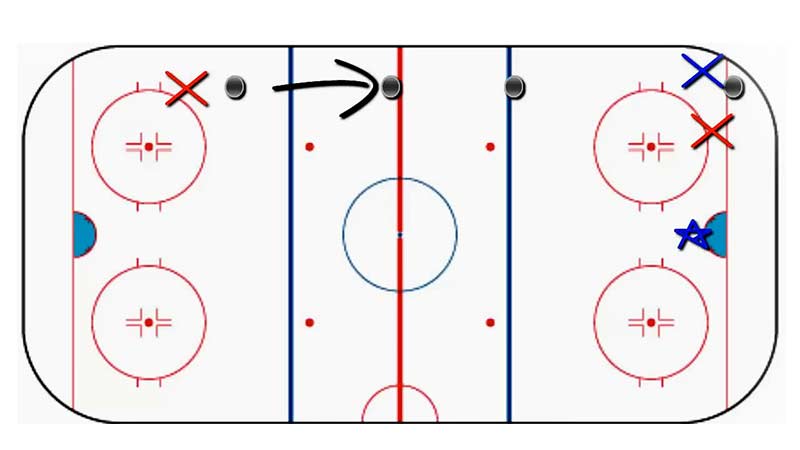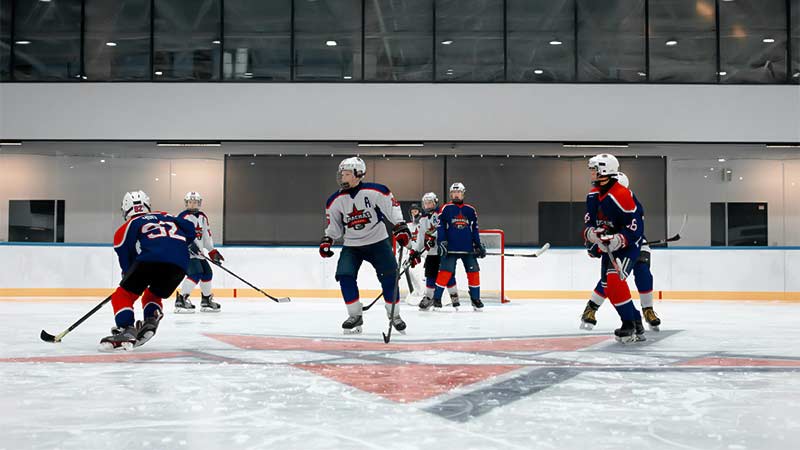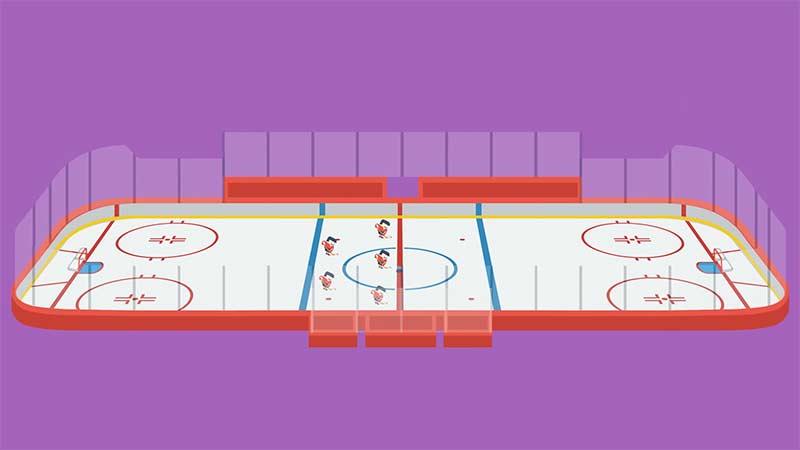In hockey, understanding the intricacies of the icing rule is crucial for players and fans alike. Icing is a fundamental aspect of the game that can impact the flow and outcome of a match.
When a team shoots the puck from behind the center line into the opponent’s zone, crossing the goal line without being touched, icing is called. This results in a stoppage of play and a faceoff in the defending team’s zone.
Knowing when icing is called, the exceptions to the rule, and how teams can benefit or be penalized by it adds depth to one’s hockey knowledge.
By delving into the nuances of the icing rule, fans can appreciate the strategic elements involved in this aspect of the game.
Stay tuned to uncover a comprehensive guide that will enhance your understanding of hockey’s icing rule and enrich your viewing experience.
Understanding Icing in Hockey
The Origin and Purpose of the Icing Rule
The rule of icing in hockey has a historical foundation rooted in encouraging offensive play and discouraging overly defensive tactics that impede the flow of the game.
Originally designed to prevent players from easily shooting the puck to the other end of the ice as a defensive strategy, icing has evolved over time.
Despite several modifications to the rule, the basic idea remains consistent: penalizing teams that attempt to gain an advantage by avoiding play in their defensive zone.
Common Scenarios for Icing the Puck
Icing in hockey commonly occurs when a defending team clears the puck from their zone to the opponent’s end past the goal line without any player making contact with it. This action results in a stoppage of play and a faceoff in the defending team’s zone.
One common scenario for icing is when a team is under pressure and attempts to relieve it by sending the puck down the ice.
Another scenario is using icing strategically to prevent an opposing team from scoring, although it comes with the consequence of not being able to make a line change after icing.
Understanding these scenarios is crucial for both players and fans to grasp the tactical nuances of the game.
Icing Rule Explained

The Basic Icing Rule
In hockey, the icing rule is applied when a player shoots or deflects the puck from their team’s half of the rink to the opponents’ goal line without any opposing player touching it.
This rule is enforced when the puck crosses both the center red line and the opposing team’s goal line untouched by any player from the opposing team.
Situations Leading to Icing Calls
Icing calls typically occur in scenarios where a team is under pressure and decides to clear the puck down the ice to relieve that pressure. It can also be strategically used to prevent the opposing team from scoring by sending the puck all the way to the other end of the rink.
Understanding these situations is key to appreciating the tactical aspects of hockey and how different teams use the icing rule to their advantage on the ice.
Variations of the Icing Rule

Touch Icing Explained
Touch icing is a traditional approach to the rule where player contact with the puck determines whether icing is called. Leagues like the NHL and IIHF still use touch icing. In this system, players race to touch the puck before it crosses the goal line to avoid an icing call.
No-touch Icing and Its Impact
No-touch icing or automatic icing is a variation aimed at player safety. Icing is called regardless of player contact with the puck to reduce collisions along the boards. Leagues worldwide use this system to prioritize player well-being.
The Adoption of Hybrid Icing
Hybrid icing is the most common variation in modern hockey. It blends touch and no-touch icing rules, combining player contact in specific zones with automatic icing in others. This method balances the need for player involvement and safety throughout the game.
Enforcement and Indicators of Icing
How Icing is Called in a Game?
In a game of ice hockey, icing is called by the referee when a player shoots the puck from their side of the center red line across the opponent’s goal line without it being touched by another player. This action results in a stoppage of play and a faceoff in the defending zone of the team that iced the puck.
Referee Signals for Icing
To indicate an icing call, the referee raises their arm with the palm facing inward and blows the whistle for confirmation. The linesman also plays a crucial role in signaling icing by crossing their arms and skating to the designated faceoff dot in the defensive zone.
In cases where icing is waved off, the linesman lowers their arm and performs the washout signal by extending both arms sideways at shoulder height, ensuring clear communication of the call during gameplay.
Icing Penalties and Exceptions
Different Types of Icing Penalties
Icing in hockey can lead to various penalties and exceptions based on different circumstances:
- Regular Icing: The most typical form of icing results in a stoppage of play and a faceoff in the defending team’s zone. This is a common occurrence during games.
- Delayed Penalty Icing: If a delayed penalty occurs, the faceoff is conducted at the neutral spot nearest the attacking team’s goal. This rule is to discourage tactical fouls.
- Erroneous Icing Call: In cases where the linesman makes a mistake in calling icing, the faceoff is set at the center faceoff spot. This exception aims to rectify human errors during gameplay.
- Exceptions: There are specific exceptions to icing where it may not be called, such as if the puck is touched by an offensive player or goaltender before crossing the goal line. These exceptions ensure fair gameplay under special circumstances.
When Icing is Permissible?
Icing is permissible in certain scenarios to maintain the flow and fairness of the game:
- Short-Handed Play: Teams that are short-handed due to a penalty can ice the puck without facing a penalty. This allows for strategic gameplay even when at a numerical disadvantage.
- Crossing Goal Line: To avoid a regular icing call, the puck must fully cross the goal line. If it comes to a stop before crossing entirely, it does not count as icing.
- Offensive Player Touch: If an offensive player or goaltender touches the puck before it crosses the goal line, icing is waved off. This exception encourages active participation and play continuation.
- Faceoff Icing: If the puck is hit or deflected to the other end during a faceoff, icing is not called. This exception ensures a fair restart of play without penalties.
Understanding the nuances of icing penalties and permissible scenarios is crucial for players, coaches, and fans to comprehend the dynamics of hockey gameplay.
Strategic Use of Icing in Games
Defensive and Offensive Strategies
Icing is a strategic tactic in hockey used to allow tired players to rest and disrupt the opponents’ momentum. It involves deliberately shooting the puck down the ice to break the flow of play and potentially regain control of the game.
Dumping the puck into the offensive zone during intense pressure can also lead to an icing call if the opposing team fails to reach it first, while delaying line changes can tire out opponents and increase the chances of an icing call when clearing the puck.
Implications for Game Play and Flow
Icing is increasingly used in hockey as a strategy to help defensive teams regroup by relieving pressure and disrupting opponents’ momentum.
However, the balance between competitive advantage and sportsmanship is a key consideration when employing this tactic, with debates surrounding its impact on fair play.
This discussion underscores the importance of maintaining a harmonious blend of strategic gameplay and ethical behavior in hockey.
Icing Rules Across Different Leagues
Comparing NHL Icing Rules to Other Leagues
Icing in the NHL involves a strategic decision for teams, where shooting the puck past the center red line and opposing goal line without it being touched results in a stoppage of play and a faceoff.
However, there is an exception where if the team that iced the puck reaches it first after crossing the goal line, they can continue play, creating a potential scoring opportunity.
Different hockey leagues may have variations in their icing rules, highlighting the importance of understanding these nuances for players, coaches, and fans to navigate rules effectively across various organizations.
How Icing Rules Have Evolved in Professional Hockey
The evolution of icing rules in professional hockey reflects the sport’s dynamic nature and continuous efforts to balance fairness and competitiveness.
Early Icing Rules: Safety Concerns and Game Flow
The rules of icing in professional hockey were introduced for safety reasons, aiming to prevent teams from repeatedly shooting the puck down the ice without consequences.
However, this regulation led to frequent stoppages in play, disrupting the game’s flow. Icing happens when a player shoots the puck over both the center red line and the opposing team’s goal line.
No-Touch Icing: Minimizing Injuries
Sports leagues introduced modified “no-touch” icing rules to address player safety and improve gameplay flow.
With this adjustment, referees could stop play once the puck crossed the goal line without requiring defensive player contact.
This rule change eliminated the need for risky races to touch the puck, reducing on-ice collisions and injuries while also speeding up game pace.
Hybrid Icing: Balancing Fairness and Strategy
Hybrid icing was introduced to address concerns about fairness in traditional icing rules by combining aspects of both touch and no-touch regulations.
This system allows the linesman to decide if the defending or attacking player has the upper hand in reaching the puck first, resulting in either a continuation of play or an icing call, which stops the game.
Automatic Icing: Enhancing Game Flow
In recent years, certain leagues have implemented automatic icing as a means to enhance the flow of the game and minimize interruptions.
This system eliminates the necessity for referees to assess icing violations subjectively. Rather, icing is promptly enforced once the puck traverses the goal line, irrespective of player placements on the ice.
Frequently Asked Questions
Can icing be called off if the goalie leaves the crease?
Icing the puck is not called if the goalie leaves the crease to play the puck, even if he does not touch it.
What is the definition of icing in hockey?
Icing is an infraction that occurs when a player shoots the puck over the center red line and the opposing team’s goal line, untouched.
Are there exceptions to the icing rule in hockey?
An exception to the icing rule is when an official rules the opposing team could have played the puck before it crossed the goal line.
How has the icing rule evolved in professional hockey?
Various hockey leagues have adapted icing rules to enhance game flow, player safety, and strategic gameplay over time.
What happens if a player scores more than three goals in a game in the Silver League?
According to the Gretzky Rule in the Silver League, if a player scores a fourth goal, it will not count, and there will be a face-off in the offensive zone.
Conclusion
Understanding the intricacies of icing rules in hockey is crucial for players, coaches, and fans alike. From the basics of enforcement to the strategic implications in gameplay, icing serves as a fundamental aspect of the sport.
As leagues continue to refine their regulations to optimize player safety and enhance the flow of the game, staying informed about the latest rule changes is essential.
By grasping the nuances of icing penalties and exceptions across different leagues, individuals can gain a deeper appreciation for how this rule shapes the dynamics of hockey matches.
Embracing the evolution of icing rules underscores the ever-evolving nature of the sport and the continuous efforts to balance tradition with innovation.








James Felix